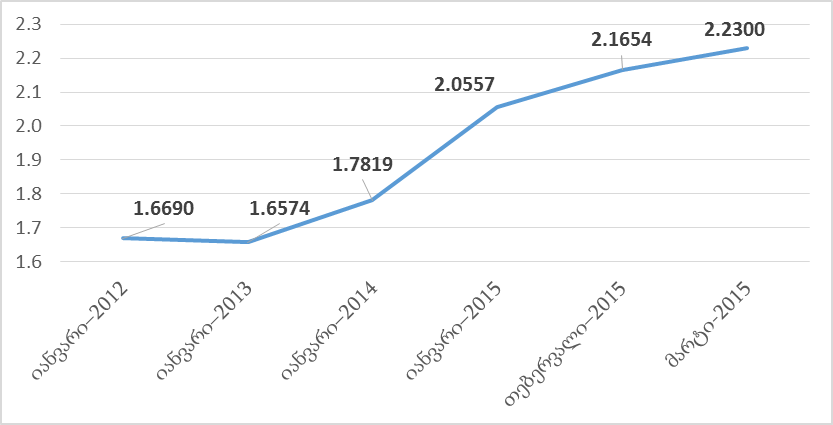United National Movement MP, Zurab Japaridze, stated: "Export has been decreasing for the seventh consecutive month since August 2014. We had a 26% fall in exports in January and February 2015. Import has also gone down. Bank loans for about 530,000 Georgian citizens have become significantly more expensive. The national currency of Georgia has depreciated by 35% under this government. The economy of Georgia had decreased by USD 35 million by the last quarter of 2014 as compared to the same quarter of 2013. This means that our country has become poorer."
FactCheck took interest in this statement and verified its accuracy.
According to the preliminary data of the National Statistics Office of Georgia, the economic growth of Georgia was 4.8% in 2014. The economy grew by only 1.8% in the last quarter of 2014. A 2% economic growth is expected in Georgia in 2015. Negative tendencies in external trade had the biggest influence upon the decrease in the growth of the GDP.
Exports from Georgia had a high level of growth at the beginning of 2014; however, the growth rate began to decrease in August and the trend continues today as well. The overall decrease in exports amounted to 2% in 2014 (see Graph 1) whilst they decreased by 36% in January and February 2015.
Graph 1: Export Indicators in 2013 and 2014
 Source: National Statistics Office of Georgia
The reason given for the decrease in exports from Georgia comprises the economic processes occurring in its trade partner countries. FactCheck wrote about this issue earlier as well. The largest portion of exports from Georgia goes to members of the Commonwealth of Independent States and so the economic processes taking place in the region seriously affect our country as well. Exports to the Commonwealth of Independent States decreased by 10% in 2014 and by 53% in January and February 2015. It should also be noted that exports decreased not only to the members of the Commonwealth of Independent States but to other countries as well.
Table 1: Growth of Exports by Groups of Countries, 2014 and January-February 2015
Source: National Statistics Office of Georgia
The reason given for the decrease in exports from Georgia comprises the economic processes occurring in its trade partner countries. FactCheck wrote about this issue earlier as well. The largest portion of exports from Georgia goes to members of the Commonwealth of Independent States and so the economic processes taking place in the region seriously affect our country as well. Exports to the Commonwealth of Independent States decreased by 10% in 2014 and by 53% in January and February 2015. It should also be noted that exports decreased not only to the members of the Commonwealth of Independent States but to other countries as well.
Table 1: Growth of Exports by Groups of Countries, 2014 and January-February 2015
Source: National Statistics Office of Georgia
The negative trade balance grew along with the decrease in exports. The negative trade balance was not compensated by other external sources throughout the year which facilitated the depreciation of the national currency by the end of the year. The exchange rate of GEL decreased by 12% in 2014 whilst it depreciated by 21% with regard to USD in the first four months of 2015.
It should also be noted that the National Statistics Office of Georgia published the data of the external trade of the first quarter of 2015 on 21 April 2015. According to these data, exports decreased by 28% from January to March 2015 as compared to the same period of the previous year whilst imports decreased by 3%.
The Government of Georgia changed in October 2012. The exchange rate of GEL with regard to USD was 1.6688 at the time. The exchange rate has reached 2.2539 today which means that the national currency has depreciated by about 35% with regard to USD since October 2012.
Given the fact that Georgia is an import-dependent country, the depreciation of the national currency has caused the prices on imported goods to increase. In addition, due to the high level of the dollarization of bank loans, the depreciation of GEL has made servicing the loans more expensive for a significant part of the public. FactCheck wrote about this issue earlier as well.
The increase in the exchange rate of the national currency has made imports more expensive which caused the imports to decrease at the beginning of 2015. Prices increased for medications and groceries, in particular, which worsened the situation for mainly low-income families.
As for the decrease of the GDP in USD, the nominal GDP amounted to GEL 8,177 million in the last quarter of 2014 which equalled USD 4,388 million according to the exchange rate in December. The nominal GDP amounted to GEL 7,691 million in the last quarter of 2013 which equalled USD 4,429 million according to the exchange rate at the time and which further means that the GDP decreased by USD 41 million. However, it must be pointed out that the real economic growth is much more important than the amount of the nominal GDP in USD. The economic growth was to have been 5% in 2015; however, according to the forecasts of the International Monetary Fund and the Government of Georgia, it will equal 2%.
Conclusion
The decrease in exports from Georgia started in August 2014 and the trend continues today as well. Exports decreased by 2% in 2014, by 36% from January to February 2015 and by 28% in the first quarter of 2015. The decrease in the country’s exports caused the worsening of the negative external trade balance of Georgia which, among other factors, caused the national currency to depreciate. Given the dependence upon imports and the high level of the dollarization of bank loans, the depreciation of the national currency caused the purchasing power of the population to decrease. Prices increased mainly for medications and groceries. Due to the depreciation of GEL, servicing bank loans became more expensive for a significant part of the population. In addition, the nominal GDP in USD decreased by USD 41 million.
FactCheck concludes that Zurab Japaridze’s statement is TRUE.
 Source: National Statistics Office of Georgia
The reason given for the decrease in exports from Georgia comprises the economic processes occurring in its trade partner countries. FactCheck wrote about this issue earlier as well. The largest portion of exports from Georgia goes to members of the Commonwealth of Independent States and so the economic processes taking place in the region seriously affect our country as well. Exports to the Commonwealth of Independent States decreased by 10% in 2014 and by 53% in January and February 2015. It should also be noted that exports decreased not only to the members of the Commonwealth of Independent States but to other countries as well.
Table 1: Growth of Exports by Groups of Countries, 2014 and January-February 2015
Source: National Statistics Office of Georgia
The reason given for the decrease in exports from Georgia comprises the economic processes occurring in its trade partner countries. FactCheck wrote about this issue earlier as well. The largest portion of exports from Georgia goes to members of the Commonwealth of Independent States and so the economic processes taking place in the region seriously affect our country as well. Exports to the Commonwealth of Independent States decreased by 10% in 2014 and by 53% in January and February 2015. It should also be noted that exports decreased not only to the members of the Commonwealth of Independent States but to other countries as well.
Table 1: Growth of Exports by Groups of Countries, 2014 and January-February 2015
| 2014 | 2015 | |
| European Union (28) | 2% | 9% |
| Commonwealth of Independent States Members (CIS) | -10% | -52.8% |
| Organization of the Black Sea Economic Cooperation (BSEC) | -6% | -48.6% |
| Organisation for Economic Co-operation and Development (OECD) | 12% | 1.5% |
| GUAM Member States | -25% | -53.8% |
Tags:








